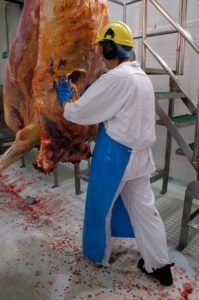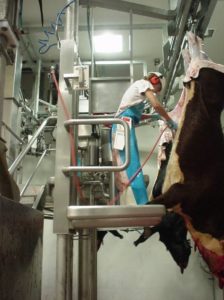Manual Handling
What is manual handling or manual tasks?
Most tasks and activities in the meat industry involve some form of manual handling or physical effort to move or hold an object, people or animals. Manual tasks cover a wide range of activities such as handling live animals, using equipment, pushing and pulling cuts of meat, transferring meat into cartons, load out activities, working on a conveyor line and entering data into a computer.
What are hazardous manual tasks?
Some manual tasks are hazardous and may cause musculoskeletal disorders. These are the most common workplace injuries across Australia.
A hazardous manual task, as defined in the WHS Regulations, means a task that requires a person to lift, lower, push, pull, carry or otherwise move, hold or restrain any person, animal or thing involving one or more of the following:
- repetitive or sustained force
- high or sudden force
- repetitive movement
- sustained or awkward posture
- exposure to vibration.
These factors directly stress the body and can lead to injury.
What injuries may be caused by manual handling or hazardous manual tasks?
Some manual tasks are hazardous and may cause musculoskeletal disorders. These are the most common workplace injuries across Australia.
A musculoskeletal disorder, as defined in the WHS Regulations, means an injury to, or a disease of, the musculoskeletal system, whether occurring suddenly or over time. These injuries may include conditions such as:
- sprains and strains of muscles, ligaments and tendons
- back injuries, including damage to the muscles, tendons, ligaments, spinal discs, nerves, joints and bones
- joint and bone injuries or degeneration, including injuries to the shoulder, elbow, wrist, hip, knee, ankle, hands and feet
- nerve injuries or compression (e.g. carpal tunnel syndrome)
- muscular and vascular disorders as a result of hand-arm vibration
- soft tissue hernias
- chronic pain.
These injuries may occur in two ways:
- gradual wear and tear to joints, ligaments, muscles and inter-vertebral discs caused by repeated or continuous use of the same body parts, including static body positions
- sudden damage caused by strenuous activity, or unexpected movements such as when loads being handled move or change position suddenly.
Injuries can also occur due to a combination of these mechanisms, for example an acute injury to the back that has been worn down over years of heavy lifting.

Repeated and continuous motion can cause strain
© MINTRAC
What are the legal requirements for controlling manual tasks?
Hazardous manual tasks (or manual handling) are specifically covered by Part 4.2 – Hazardous Manual Tasks – of the model Work Health and Safety Regulations. Regulation 60 states that senior managers must manage risks to health and safety relating to a musculoskeletal disorder associated with a hazardous manual task.
There is also a Code of Practice – Hazardous Manual Tasks. The Code explains how to identify hazardous manual tasks, assess the risks of musculoskeletal disorders and eliminate or minimise those risks. To have legal effect in a jurisdiction, the Code of Practice must be approved as a code of practice in that jurisdiction.
How are the risks associated with manual tasks controlled?
Hazardous manual tasks are controlled in the same way as other hazards in the workplace through a risk control program. The four steps in controlling risks to eliminate them or reduce them to the lowest possible levels before they cause injuries are to:
- identify the hazards
- assess the risks
- control risks
- review control measures.

Rise and fall platforms reduce risk of manual handling injury
© MINTRAC
